
A cherry blossom is a flower of several trees of genus Prunus, particularly the Japanese cherry, Prunus serrulata, which is called sakura after the Japanese.

Byrsonima crassifolia is a species of flowering plant bearing fruit in the acerola family, Malpighiaceae, that is native to tropical America. Common names include changunga, muruçi, nanche, nance, chacunga, craboo, kraabu, savanna serrette and golden spoon. In Jamaica it is called hogberry.

Acer is a genus of trees and shrubs commonly known as maple. The genus is placed in the family Sapindaceae. There are approximately 128 species, most of which are native to Asia, with a number also appearing in Europe, northern Africa, and North America. Only one species, Acer laurinum, extends to the Southern Hemisphere. The type species of the genus is the sycamore maple, Acer pseudoplatanus, the most common maple species in Europe. The maples have easily recognizable palmate leaves and distinctive winged fruits. The closest relatives of the maples are the horse chestnuts.

Byrsonima is one of about 75 genera in the Malpighiaceae, a family of flowering plants in the order Malpighiales. In particular in American English, they are known as locustberries. Another widely seen common name is serrets or serrettes.
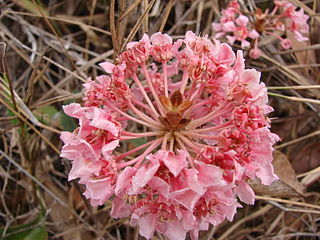
Pterandra is a genus in the Malpighiaceae, a family of about 75 genera of flowering plants in the order Malpighiales. Pterandra comprises 15 species of trees, shrubs, and subshrubs, all but two native to South America, principally Colombia, Venezuela, and Brazil; the exceptions are from Panama.
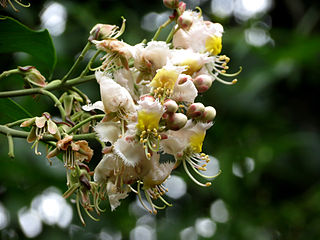
Hiptage benghalensis, often simply called hiptage, is a perennial, evergreen liana native to India, Southeast Asia and the Philippines. Its habitat is variable and prefers climates ranging from warm temperate to tropical. In Hawaii, where H. benghalensis is considered a weed, as it is in Australia, Mauritius and Réunion, it grows from sea level to 1,000 m (3,281 ft). H. benghalensis is cultivated for its white-pink scented flowers.
Barnebya is a genus in the Malpighiaceae, a family of about 75 genera of flowering plants in the order Malpighiales. Barnebya comprises 2 species of trees and woody vines native to eastern Brazil. The genus is named in honor of the American botanist Rupert Charles Barneby (1911–2006).
Acridocarpus socotranus is a species of plant in the family Malpighiaceae. It is endemic to Socotra, an archipelago which is part of Yemen. It occurs in woodlands, thickets, and succulent shrubland habitat, where it is a common species.
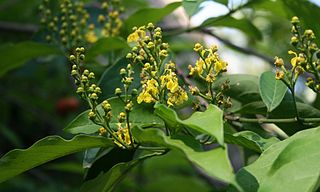
Bunchosia is a genus in the Malpighiaceae, a family of about 75 genera of flowering plants in the order Malpighiales. It contains roughly 75 species of trees and shrubs, which are native to dry woodlands, savannas, and wet forests. Their range extends from Mexico and the Caribbean to southeastern Brazil and adjacent Argentina. Bunchosia is one of three arborescent genera of Malpighiaceae with fleshy, bird-dispersed fruits.
Spachea correae is a species of plant in the Malpighiaceae family. It is found in Costa Rica and Panama. It is threatened by habitat loss.
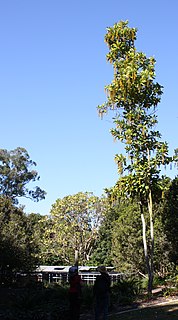
Lophanthera is a genus in the Malpighiaceae, a family of about 75 genera of flowering plants in the order Malpighiales. Lophanthera comprises 5 species of shrubs and trees, all but one native to the Amazonian South America; the exception is from Costa Rica. Lophanthera lactescens has become popular in recent decades as a cultivated ornamental in many warm regions of the Old and New World. It is propagated by cuttings and seeds.
Diacidia is a genus in the Malpighiaceae, a family of about 75 genera of flowering plants in the order Malpighiales. Diacidia comprises 11 species of trees, shrubs, and subshrubs. Ten species are found on the mountains of southern Venezuela and adjacent Brazil; one species is widespread in the drainages of the Rio Negro and the Río Vaupés in Venezuela, Colombia, and Brazil.
Heladena is a genus in the Malpighiaceae, a family of about 75 genera of flowering plants in the order Malpighiales. Heladena includes one species, Heladena multiflora, a woody vine or sometimes a shrub or small tree native to gallery forests and woodlands of southern Brazil, Paraguay, and northeastern Argentina.
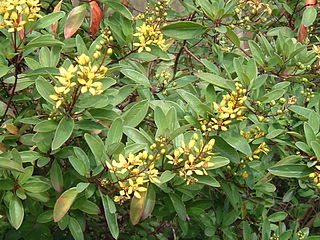
Galphimia gracilis, a species in the genus Galphimia of the family Malpighiaceae, is native to eastern Mexico. It is widely cultivated in warm regions throughout the world, often under the common names gold shower or shower-of-gold, slender goldshower or sometimes thryallis. In horticultural publications, in the nursery trade, and on websites, this species is commonly but mistakenly referred to as Galphimia glauca, Galphimia brasiliensis, Thryallis glauca, Thryallis gracilis, or often in South America, Thryallis brasiliensis.
Lophopterys is a genus in the Malpighiaceae. Lophopterys comprises seven species of woody vines and shrubs of diverse habitats in South America south to about 23°.
Psychopterys is a genus in the Malpighiaceae, a family of about 75 genera of flowering plants in the order Malpighiales. Psychopterys comprises 8 species of woody vines, occasionally described as shrubs or small trees, which occur in matorral, tropical deciduous forest, and wet forest in southern Mexico, Guatemala, and Belize. This genus is very distinctive because of its nearly radial white corollas and eglandular sepals, which are highly unusual characteristics in the Malpighiaceae of the New World.

Malpighia glabra is a tropical fruit-bearing shrub or small tree in the family Malpighiaceae. It has often been confused with the cultivated crop tree M. emarginata, but has small insipid fruit and a very different flower structure.

Byrsonima lucida is a species of plant in the Malpighiaceae family. It is endemic to islands in the Caribbean and to the U.S. state of Florida. It is a shrub or small tree, and produces pink flowers. Its natural habitat is hammocks in dry limestone rocklands, and in sandy pine-palm woods.
Spachea elegans is a species of flowering plants in the family Malpighiaceae. It is found in Brazil and Venezuela.











